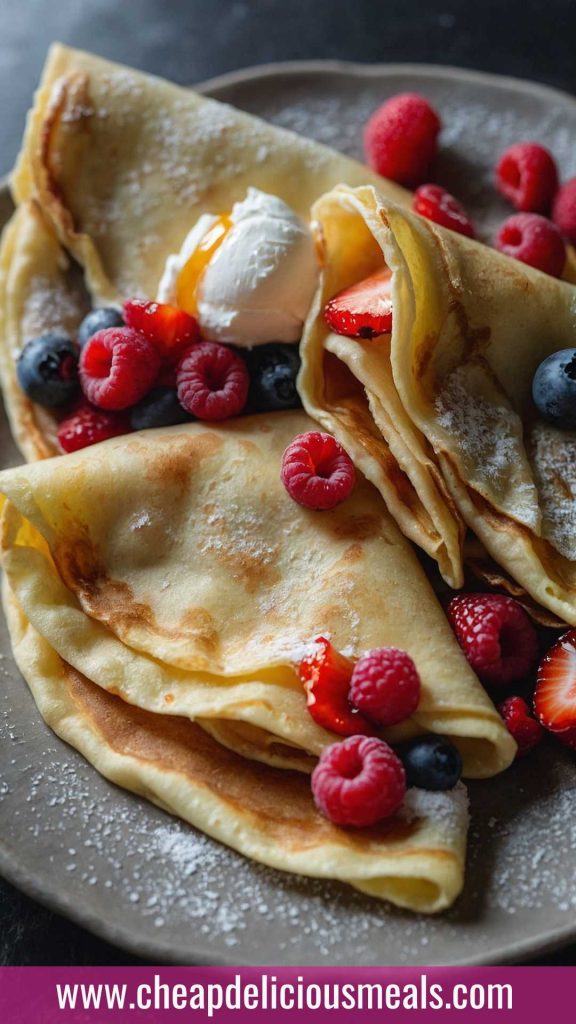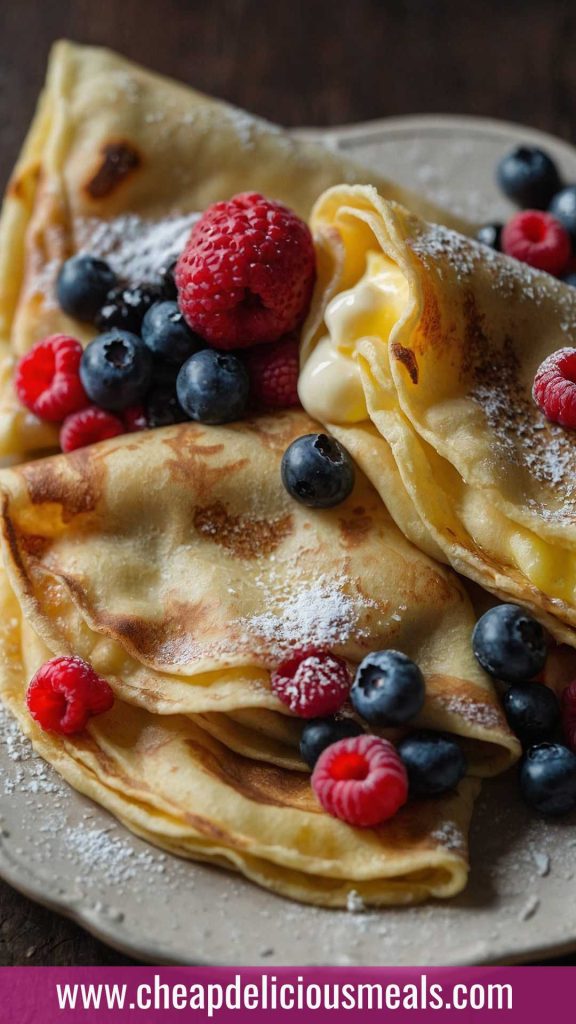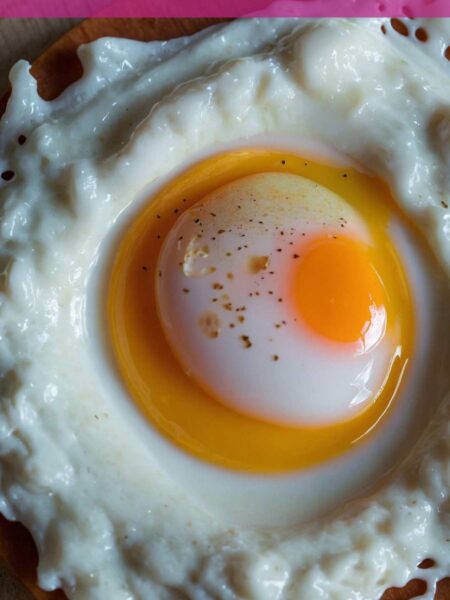When it comes to homemade crepes, the possibilities for pairings are practically endless. You might be tempted to fill them with classic ingredients like Nutella and strawberries, or perhaps you lean towards savory options like ham and cheese.
Trust me, you can dress them up for breakfast, lunch, dinner, or even dessert. They adapt beautifully. Besides, everyone loves a good crepe, and I get into the groove of creativity every time I whip up a batch.
Let’s kick off this culinary journey by saying: if there’s one thing I enjoy more than cooking, it’s sharing my love of food. There’s joy in transforming simple ingredients into something marvelous, and crepes epitomize that experience. Let’s dive right into the delicious world of homemade crepes!

Homemade crepes have a charm all their own, blending simplicity with elegance. They are thin pancakes that boast versatility. You can fill them with sweet or savory ingredients, making them a beloved dish in many cultures, especially in France. But how did these delightful creations make their way into our hearts?
Personally, I remember the first time I made a crepe. I was a novice in the kitchen, and the idea seemed daunting. However, one bite into that perfectly-made crepe filled with fresh berries was a revelation. They had this uncanny ability to evoke memories, hinting at comfort and delight.
Join me as I share everything you need to know about making homemade crepes, from what they are to how they taste, and why you’ll want to keep making them.
You Might Also Like These Recipes!
What Are Homemade Crepes?
At their core, homemade crepes are exceedingly thin pancakes typically made from a batter of eggs, flour, milk, and butter. They differ from regular pancakes, as they’re much thinner and can be filled or topped with a variety of ingredients. You might think they are challenging, but once you get the hang of them, you become a crepe-making wizard in your own kitchen.
Their flavor is subtle but can be enhanced wonderfully with fillings. The history of crepes is rich. Originating in Brittany, France, they were made from buckwheat and served with savory fillings. Sweet versions followed, and today, you can find them filled with everything from fruits and creams to meats and cheeses.
What Does It Taste Like?
Homemade crepes have a gently sweet and buttery flavor that lends themselves well to both sweet and savory fillings. When cooked to perfection, they are slightly crisp on the edges yet tender in the center. The way they yield to fillings creates a delightful texture combination that’s hard to resist.
Fresh fruit, creamy mascarpone, or rich chocolate can elevate them to a dessert level, while slivers of ham, melted cheese, or sautéed veggies make them a treat for lunch or dinner. Each bite is a blend of flavors that speaks to the versatility baked into this dish.
Why This Recipe Works
1. Simplicity That Delivers:
This recipe includes basic ingredients that you likely already have at home. With just a few staple items, you can create crepes that are beyond what you’d expect from a pancake.
2. Quick Preparation:
Making the crepe batter takes mere minutes. With a hot pan and your batter ready, you can pour, flip, and serve in no time. It’s the perfect choice for a busy day.
3. Endless Customization:
You truly can make this dish your own. Whether you’re in the mood for something sweet and fruity or prefer a hearty savory option, the filling possibilities are boundless.
4. Impressive Final Product:
Homemade crepes, when presented, look stunning. The very act of making them gives you chef-level credentials. Guests will be impressed, and you’ll feel a rush of pride, too!
Ingredients for Homemade Crepes
To get rolling (literally!), here’s what you’ll need:
- 2 large farm-fresh eggs, room temperature preferred
- 1 and 1/2 teaspoons real vanilla extract
- 1 cup (125g) finely sifted all-purpose flour (measured by spoon & leveled)
- 1/2 cup (120ml) filtered water, at room temperature
- 3 Tablespoons (43g) unsalted butter, plus 3–4 extra Tablespoons (43g to 56g) for greasing the pan
- 1 Tablespoon cane sugar
- 3/4 cup (180ml) whole milk, brought to room temperature
- 1/2 teaspoon ground cinnamon
- 1 teaspoon freshly grated orange zest
Step-by-Step Instructions
Step 1: Make the Batter
Start by gathering all your ingredients. In a mixing bowl, whisk together the eggs and sugar until the mixture is smooth. Add in the vanilla extract and the orange zest—this will give your crepes a delightful hint of sophistication.
Step 2: Combine the Dry Ingredients
In another bowl, sift the flour and cinnamon together. Gradually add the dry ingredients to the egg mixture. Combine as you go. This prevents lumps.
Step 3: Add the Liquids
Once your batter is lump-free, pour in the milk and water. Mix gently until you achieve a silky consistency. Don’t rush this part; it’s key to the texture.
Step 4: Let the Batter Rest
Cover the bowl with plastic wrap or a towel and let it rest for about 30 minutes. Relaxing allows the gluten in the flour to settle.
Step 5: Heat the Pan
Put a non-stick skillet or crepe pan over medium heat. Add a small knob of butter, allowing it to melt and coat the pan.
Step 6: Pour the Batter
Using a ladle, pour about 1/4 cup of batter into the center of the pan. Immediately tilt and swirl the pan to spread the batter evenly.
Step 7: Cook Until Golden
Cook the crepe for about 1-2 minutes until the edges lift and the bottom is golden brown. Flip and cook for another 1 minute. Repeat the process until all the batter is used, stacking the crepes on a plate.

Notes
- Resting the Batter: Don’t skip the resting step; it’s crucial!
- Pan Heat: Make sure your pan is the right temperature. Too hot and the crepes will burn; too cool and they won’t cook properly.
- Grease Sparingly: Use just enough butter to grease the pan—no one wants a greasy crepe.
- Watch Closely: Crepes cook fast. Stay attentive; you want that beautiful golden color.
- Storage: Keep cooked crepes wrapped in foil or in a sealed container to retain moisture.
Nutrition Information
Each homemade crepe (when made with specified ingredients) contains approximately:
- Calories: 150
- Protein: 4g
- Carbohydrates: 20g
- Fat: 6g
- Fiber: 1g
- Sugar: 1g

How to Store the Leftovers?
Cooked crepes can be stored in an airtight container or wrapped in plastic wrap and kept in the refrigerator for up to three days. For longer storage, consider freezing them. Place wax paper between each crepe before sealing in a freezer bag. They will keep for about a month.
Sides for Homemade Crepes
What you pair with crepes can elevate the whole meal. Here are some sides to complement your masterpiece:
1. Fresh Fruit Salad:
Combine seasonal fruits such as berries, bananas, and melon for a refreshing contrast. Toss them in a little honey or mint for an extra kick.
2. Creamy Yogurt:
A dollop of Greek yogurt pairs wonderfully with sweet crepes—especially if you add a drizzle of honey or a sprinkle of granola for texture.
3. Sautéed Spinach and Garlic:
If you’re going savory, sauté spinach with a hint of garlic. This makes for a wholesome side that balances out the richness of the crepes.
4. Maple Syrup or Honey:
For sweet options, maple syrup or honey always hits the mark. It’s a staple that gives a delightful sweetness, enhancing the flavor of your creations.
What Are Some Alternative Choices to the Ingredients?
Sometimes, you must improvise with what’s in your pantry. Here are some alternatives:
1. Egg Replacement:
If you’re out of eggs, use a flaxseed meal substitute—mix 1 tablespoon of flaxseed meal with 2.5 tablespoons of water. Let it sit for a few minutes until it thickens.
2. Non-Dairy Milk:
Almond, soy, or oat milk can replace whole milk. This is particularly useful for those with dairy allergies.
3. Coconut Oil:
Instead of butter, coconut oil works as a suitable alternative, adding a subtle tropical flavor that can be delightful in sweet crepes.
4. Gluten-Free Flour:
For those requiring gluten-free options, gluten-free flour blends provide an excellent substitution for all-purpose flour.
Conclusion
Homemade crepes have a way of bringing joy to any kitchen. They remind us that cooking can be both simple and special. As we’ve explored, the preparation is straightforward, and the results are breathtaking, whether you’re crafting a sweet treat or a savory dish. With a little practice, you can master this classic and impress family and friends.
Next time you’re looking for a versatile meal, remember these delicate delights. Whether served with fruit and cream for breakfast or filled with cheese and veggies for dinner, homemade crepes are a culinary canvas waiting for your touch. Happy cooking!
You Might Also Like These Latest Recipes!

Homemade Crepes – Cheap Delicious Meals
Description
Homemade crepes have a charm all their own, blending simplicity with elegance. They are thin pancakes that boast versatility. You can fill them with sweet or savory ingredients, making them a beloved dish in many cultures, especially in France. But how did these delightful creations make their way into our hearts?
Personally, I remember the first time I made a crepe. I was a novice in the kitchen, and the idea seemed daunting. However, one bite into that perfectly-made crepe filled with fresh berries was a revelation. They had this uncanny ability to evoke memories, hinting at comfort and delight.
Ingredients
Instructions
Step 1: Make the Batter
-
Start by gathering all your ingredients. In a mixing bowl, whisk together the eggs and sugar until the mixture is smooth. Add in the vanilla extract and the orange zest—this will give your crepes a delightful hint of sophistication.
Step 2: Combine the Dry Ingredients
-
In another bowl, sift the flour and cinnamon together. Gradually add the dry ingredients to the egg mixture. Combine as you go. This prevents lumps.
Step 3: Add the Liquids
-
Once your batter is lump-free, pour in the milk and water. Mix gently until you achieve a silky consistency. Don’t rush this part; it’s key to the texture.
Step 4: Let the Batter Rest
-
Cover the bowl with plastic wrap or a towel and let it rest for about 30 minutes. Relaxing allows the gluten in the flour to settle.
Step 5: Heat the Pan
-
Put a non-stick skillet or crepe pan over medium heat. Add a small knob of butter, allowing it to melt and coat the pan.
Step 6: Pour the Batter
-
Using a ladle, pour about 1/4 cup of batter into the center of the pan. Immediately tilt and swirl the pan to spread the batter evenly.
Step 7: Cook Until Golden
-
Cook the crepe for about 1-2 minutes until the edges lift and the bottom is golden brown. Flip and cook for another 1 minute. Repeat the process until all the batter is used, stacking the crepes on a plate.
Nutrition Facts
Servings 14
- Amount Per Serving
- Calories 150kcal
- % Daily Value *
- Total Fat 6g10%
- Total Carbohydrate 20g7%
- Dietary Fiber 1g4%
- Sugars 1g
- Protein 4g8%
* Percent Daily Values are based on a 2,000 calorie diet. Your daily value may be higher or lower depending on your calorie needs.
Note
- Resting the Batter: Don’t skip the resting step; it’s crucial!
- Pan Heat: Make sure your pan is the right temperature. Too hot and the crepes will burn; too cool and they won't cook properly.
- Grease Sparingly: Use just enough butter to grease the pan—no one wants a greasy crepe.
- Watch Closely: Crepes cook fast. Stay attentive; you want that beautiful golden color.
Storage: Keep cooked crepes wrapped in foil or in a sealed container to retain moisture.





